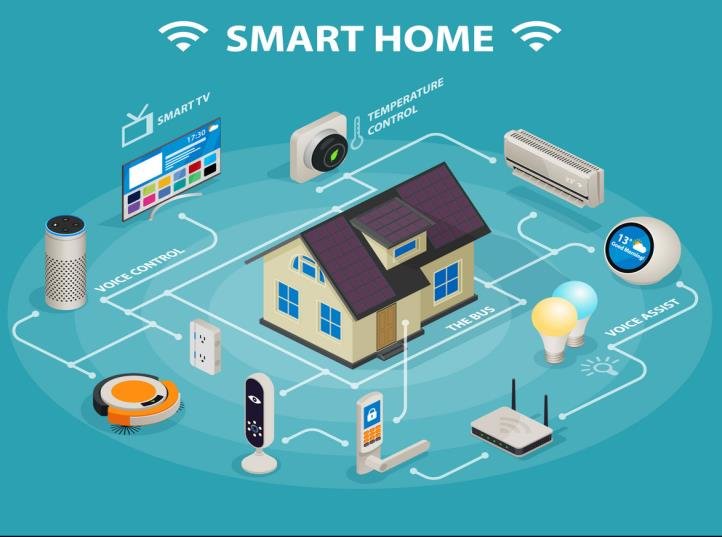A network of interconnected devices that use the internet to communicate with one another is known as the Internet of Things (IoT). These gadgets include kitchen appliances, thermostats, security cameras, and smart lights. With smartphones or voice assistants like Alexa or Google Home, people can remotely operate and automate their houses thanks to the Internet of Things. IoT in smart homes has grown in popularity as a result of technological advancements, which have made daily chores simpler and more effective.
In recent years, smart home automation has grown rapidly. Nowadays, a lot of individuals utilize IoT devices to boost convenience, conserve energy, and improve security. For instance, security cameras provide real-time alerts and smart thermostats automatically change the temperature. As technology advances, more homes will adopt IoT in smart homes to create a smarter and more connected living environment.
Essential IoT Devices for Smart Homes
Before setting up an IoT-based smart home, you need the right devices:
- Smart Home Security Systems: Smart locks, video doorbells, and motion sensors provide remote monitoring and access control.
- Smart Lighting Solutions: Wi-Fi-enabled bulbs and motion-activated lights allow customizable lighting control.
- IoT-Based Smart Thermostats: Devices like Nest and Ecobee optimize heating and cooling to save energy.
- Voice-Controlled Smart Assistants: Amazon Alexa, Google Home, and Apple Siri allow voice control for various smart devices.
- Connected Home Appliances: IoT-enabled refrigerators, ovens, and washing machines enhance convenience and automation.

Setting Up an IoT Smart Home Network
To integrate IoT devices, a strong Wi-Fi network is essential. Here’s how to set up your smart home network:
- Choose an IoT Ecosystem: Google Home, Apple Home-Kit, or Amazon Alexa for centralized control.
- Use a Smart Home Hub: Devices like Samsung Smart-Things help manage multiple IoT devices seamlessly.
- Ensure Device Compatibility: Before purchasing, verify that your smart devices work together within your ecosystem.
- How to Make Your Smart Home Automated Your IoT devices may communicate with each other seamlessly when you use IoT automation? Here’s how!
Establish Smart Routines and Automation: To establish planned automation, use apps such as Home Assistant.
Use “If This Then That” (IFTTT) to automate your home: IFTTT allows you to connect various smart gadgets to create personalized automation.
Establish Voice-Activated Controls for Your Smart Home: Use voice assistants to operate lighting, appliances, and security.
Observe and Manage via Smartphone Apps: Use apps like Apple HomeKit or Google Home to control your smart home from anywhere.
Enhancing Security and Privacy in IoT Smart Homes
Because linked devices collect and exchange personal data, security is a key concern when utilizing IoT in smart homes. To gain access to smart home systems, hackers may target insecure networks or weak passwords. Always create strong passwords and turn on encryption on your Wi-Fi network to keep safe. This keeps your IoT devices safe and stops unwanted access.
It’s also critical to update device firmware and security patches on a regular basis to address vulnerabilities that hackers could exploit.
Using a VPN (Virtual Private Network) is another method to increase IoT security in smart homes. Your internet traffic is encrypted with a VPN, which makes it more difficult for hackers to intercept data. This is particularly helpful for remote control of smart gadgets.
Future Trends in IoT for Smart Homes
IoT-enabled smart homes have a promising future because to advancements like:
AI-Powered Smart Home Appliances: AI will improve speech recognition and automation.
5G and IoT Connectivity: Smoother device communication through faster and more dependable connectivity.
Block-chain-based smart home security: decentralized defenses against intrusions.
Sustainable and Energy-Efficient Technologies: Green energy solutions will be the main emphasis of IoT-driven smart homes.

Conclusion:
There are many advantages to integrating IoT into smart homes, such as increased energy efficiency, convenience, and security. Automated appliances, security systems, and smart assistants make daily chores simpler and more effective. However, in order to combat cyber dangers in IoT in smart homes, it is crucial to prioritize security by using strong passwords, updating equipment, and encrypting data.
With developments in AI, 5G connection, and block-chain security, the Internet of Things in smart homes appears to have a bright future. Smart homes will get even smarter and more effective as technology develops further. Reducing energy usage will also be greatly aided by IoT solutions that are energy-efficient and sustainable. Homeowners may optimize the advantages of IoT in smart homes and make living safer, smarter, and more convenient by remaining informed and using the newest developments.